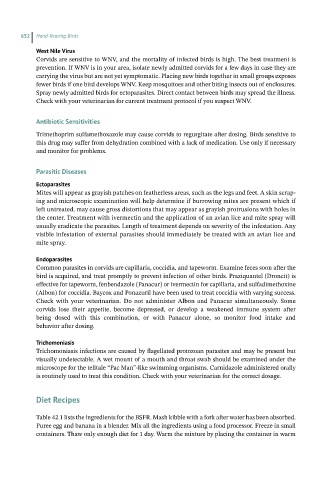Page 651 - Hand rearing birds second
P. 651
652 Hand-Rearing Birds
West Nile Virus
Corvids are sensitive to WNV, and the mortality of infected birds is high. The best treatment is
prevention. If WNV is in your area, isolate newly admitted corvids for a few days in case they are
carrying the virus but are not yet symptomatic. Placing new birds together in small groups exposes
fewer birds if one bird develops WNV. Keep mosquitoes and other biting insects out of enclosures.
Spray newly admitted birds for ectoparasites. Direct contact between birds may spread the illness.
Check with your veterinarian for current treatment protocol if you suspect WNV.
AntibioticSensitivities
Trimethoprim sulfamethoxazole may cause corvids to regurgitate after dosing. Birds sensitive to
this drug may suffer from dehydration combined with a lack of medication. Use only if necessary
and monitor for problems.
Parasitic Diseases
Ectoparasites
Mites will appear as grayish patches on featherless areas, such as the legs and feet. A skin scrap -
ing and microscopic examination will help determine if burrowing mites are present which if
left untreated, may cause gross distortions that may appear as grayish protrusions with holes in
the center. Treatment with ivermectin and the application of an avian lice and mite spray will
usually eradicate the parasites. Length of treatment depends on severity of the infestation. Any
visible infestation of external parasites should immediately be treated with an avian lice and
mite spray.
Endoparasites
Common parasites in corvids are capillaria, coccidia, and tapeworm. Examine feces soon after the
bird is acquired, and treat promptly to prevent infection of other birds. Praziquantel (Droncit) is
effective for tapeworm, fenbendazole (Panacur) or ivermectin for capillaria, and sulfadimethoxine
(Albon) for coccidia. Baycox and Ponazuril have been used to treat coccidia with varying success.
Check with your veterinarian. Do not administer Albon and Panacur simultaneously. Some
corvids lose their appetite, become depressed, or develop a weakened immune system after
being dosed with this combination, or with Panacur alone, so monitor food intake and
behavior after dosing.
Trichomoniasis
Trichomoniasis infections are caused by flagellated protozoan parasites and may be present but
visually undetectable. A wet mount of a mouth and throat swab should be examined under the
microscope for the telltale “Pac Man”-like swimming organisms. Carnidazole administered orally
is routinely used to treat this condition. Check with your veterinarian for the correct dosage.
Diet Recipes
Table 42.1 lists the ingredients for the BSFR. Mash kibble with a fork after water has been absorbed.
Puree egg and banana in a blender. Mix all the ingredients using a food processor. Freeze in small
containers. Thaw only enough diet for 1 day. Warm the mixture by placing the container in warm

